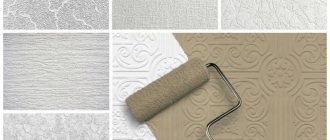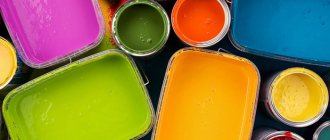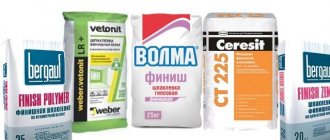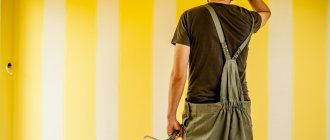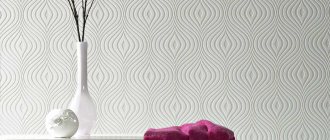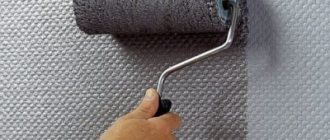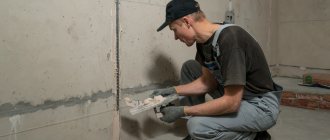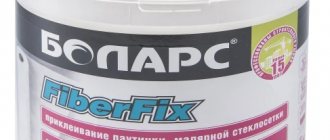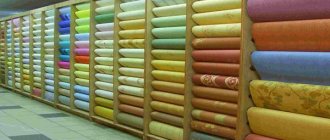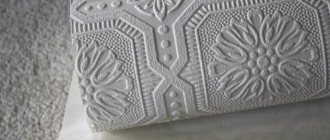Do I need to prime wallpaper before painting?
Various materials are used for decorative finishing of walls and ceilings indoors. The simplest and most popular method is wallpapering. The wallpaper market offers a wide range of these materials: from traditional paper to natural-based products, glass wallpaper and even “liquid” ones. A separate niche is occupied by wallpaper for painting.
In order to correctly install the decorative coating, and then apply a high-quality color layer, you need to know and follow the technological process of repair work. Should wallpaper be primed before painting, how and with what?
What wallpaper materials are intended for painting?
Using paintable wallpaper in the interior, on the one hand, is very beneficial. If desired, you can always carry out cosmetic repairs by refreshing or completely replacing the color. And you won’t need to re-wallpaper the walls. It is very practical and always original.
Typically, wallpaper intended for painting is white and has some textural feature. They come in different types:
The type of base affects the durability of the finish, decorative qualities and the cost of repairs. First you need to install the wallpaper materials, and this is a rather important stage of work. It is necessary to properly prepare the walls for pasting:
- level,
- prime,
- plaster
- polish,
- clean from dust and dirt,
- prime again.
Only then is the installation of wallpaper materials carried out. For example, glass wallpaper is distinguished by its hypoallergenic properties. They are antistatic. And the natural raw materials used in their production make glass wallpaper non-toxic and environmentally friendly.
True, the finishing fabric is heavier than ordinary paper wallpaper, so stronger glue and, of course, a special primer are used. For heavy wallpaper, latex or acrylic primer mixtures with high adhesion are intended.
By the way, glass wallpaper does not require applying glue to the canvas, but only to the surface being treated. During work, you must take precautions - wear gloves and long sleeves.
Fiberglass wallpaper is a canvas made of small glass threads, particles of which, if they get on an open area of the skin, can cause irritation.
How to glue wallpaper
In order for everything to be fine in your interior, and for the glass breakers to perform their functions as expected, you should stick them correctly. There is a whole gluing technology here. Therefore, answering the question “how to glue glass wallpaper for painting”, two words are indispensable.
The technology for gluing glass wallpaper includes several stages. It is important that each stage is carried out efficiently and in strict compliance with all requirements.
At the very beginning, preparation should be made. It involves the following actions:
- It is necessary to dismantle the old finish (wallpaper, paint, etc.).
- Large surface defects (cracks, potholes, etc.) should be filled with putty. Fiberglass wallpaper can only mask minor defects.
- After all the finishing has been removed and the wall defects have been puttied, the entire working surface needs to be primed. This will strengthen the outer layer of the walls or ceiling. Please note that you can prime before applying putty. This will prevent the formation of defects in the future at this very place.
Related article: Do-it-yourself lifting bed: manufacturing and assembly
Preparation is completed by applying a primer after all defects have been eliminated. To increase the adhesion of the two surfaces, the primer should be applied in several layers.
After this, you can proceed to the second stage - preparing the glue. The evenness of the treated surface and the service life of the finish will depend on how well and correctly the adhesive composition was prepared.
Please note that the most common mistake at this stage is the use of glue for paper analogues.
In this situation, you cannot use adhesive mixtures for paper wallpaper for the reason that the density of glass wallpaper is much higher. Standard wallpaper glue will not be able to withstand the weight of such sheets, and they will very quickly lag behind the ceiling or wall surface.
For glass wallpaper, you should use a special glue, which finishing manufacturers produce as an addition. Please note that this glue can only be used for gluing glass wallpaper. Here you can use glue with colored pigment (for example, Oscar). It makes it possible to evaluate the uniformity of coating of the working surface with the adhesive composition.
You should also remember that the glue still needs to be prepared correctly. It is sold in powder form and prepared according to the special instructions indicated on the package. The dry mixture is diluted with water in a certain ratio and stirred until smooth.
In addition, it should be noted that there are types of glass wallpaper for which you do not need to purchase glue. They already contain an adhesive layer. To make them stick to the wall or ceiling, simply moisten this layer with water. You can learn about all the features of this product from the seller or from the information provided on the packaging.
Now that the preparation and preparation of the adhesive mixture is behind us, we proceed to the third and final stage - gluing the glass wallpaper. The technology procedure itself is practically no different from gluing paper wallpaper.
In order to properly glue glass wallpaper onto the prepared surface, you must remember the following nuances:
- during work and after its completion, until the adhesive solution has completely dried, there should be no drafts in the room where the work was carried out;
- gluing occurs at room temperature;
- During gluing, the work surface should not be exposed to direct sunlight (curtains or blinds can be used to protect from the sun).
It is worth noting here that fiberglass may crumble during the gluing process. Therefore, to avoid excessive irritation of the skin of your hands and face, you will need additional equipment in this situation. To avoid unwanted effects from your body, gluing glass wallpaper is carried out in the following form:
- clothing must have long sleeves and long legs;
- You should wear socks on your feet and gloves on your hands;
- To protect your eyes from small fragments, you should wear safety goggles on your face.
It should also be remembered that glass wallpaper, like other types of wallpaper, has a front and back side. In a roll, the front side is always on the inside. But at the same time, a special mark in the form of a gray or blue stripe is still placed on the reverse side.
The gluing process itself is as follows:
- First, cut the roll into strips of the required length. Be sure to cut the strips in such a way that it is possible to compensate for losses due to the pattern (when using textured types).
- We coat the walls with the prepared adhesive. The glue is applied only to the surface of the walls or ceiling, and not to the sheets. To apply it evenly, use a roller or brush.
- We glue the strips end to end. This is the most important point, since the strips must touch each other without cracks or gaps.
- After fixing the strip, you should go over it with a dry and clean roller to remove air and excess adhesive. Instead of a roller, you can use a clean special spatula. At the joints, the glue must be removed with a rag or sponge.
The described technology is applicable for gluing wallpaper on the ceiling or walls. If you did everything correctly, then glass wallpaper will last on the surface of the ceiling or walls for up to 30 years, even after repeated repainting.
Related article: How to hang a lamp on the ceiling yourself?
Preparing the pasted surface for painting
The wallpaper is pasted - now you can move on to painting work. If we have special wallpaper for painting, do we need a primer before applying the decorative coating? Which one should I use?
On primed wallpaper materials, the paint applies smoothly and without streaks. In addition, the intermediate solution reduces paint consumption. Manufacturers of paint and varnish products also offer a more economical method of painting wallpaper - primer-paint as a decorative coating.
Since it is recommended to paint in at least two layers, using such materials you reduce the number of surface treatments. Instead of priming and two layers of coloring, you get priming with coloring and final color fixation.
When choosing a primer mixture for wallpaper, be guided by the type of wallpaper materials, as well as the composition of the paint. Under glass wallpaper, which must be primed before painting, you can use almost any primer mixture, including diluted wallpaper glue. But usually the choice is made in favor of the composition of the finishing coating: acrylic with acrylic, latex with latex or a universal solution.
Apply the primer solution to the front surface of the wallpaper with a roller or wide brush. Before applying, you need to make sure that the wallpaper glue is dry. This means that it is advisable to carry out the treatment a few hours after installation or the very next day.
If you plan to use water-based or water-dispersion paint in the future, the primer should have improved water-repellent properties.
The primer mixture itself is required:
- to improve the adhesive properties of the base and topcoat (paint),
- as additional protection for wallpaper,
- to increase the strength and durability of the finish,
- to reduce paint consumption,
- for coloring without streaks and stains.
Leave the treated wallpaper until the coating is completely dry. You need to wait at least 12 hours. Before applying the paint, stir it thoroughly. If too concentrated, dilute.
Substances that are more liquid in consistency are applied to the wallpaper in a thin layer. This is very important for high-quality wall painting.
Experts insist that painting wallpaper will work better if you apply several thin layers of decorative coating rather than one thick one. Before applying each new layer, the previous one must be completely dry. The break time in work depends on the technical characteristics of the paintwork material.
On average, wallpaper materials intended for painting can withstand up to 6 cosmetic repairs. However, many coats of paint will affect the visual appeal of the finish over time.
Source: pechistroy.ru
Choosing paint for wallpaper
Water-based paint can be used to paint almost any type of wallpaper. However, it is worth paying attention to the quality and characteristics of the paint, especially if the task is to create a washable coating that will be easy to care for.
Wallpaper paint from Flugger
Flugger offers consumers several color options:
- A good choice would be, for example, wallpaper paint FLUGGER FLUTEX 10 , which creates a durable coating and is resistant to washing and local cleaning. A wall painted with this product creates a very beautiful, silky matte finish with a soft, muted sheen. Especially if the wallpaper has a pronounced texture pattern, then Flutex 10 will highlight it favorably.
- To create a matte finish, choose a wallpaper paint with a lower gloss level, such as FLUGGER FLUTEX 5 , which creates a beautiful, deep matte finish that is easy to maintain. It can withstand light wet cleaning. This will be an ideal option for rooms with low traffic, such as living rooms and living rooms.
- It is recommended to paint walls that are subject to greater contamination with a more wear-resistant wallpaper paint, such as FLUGGER DEKSO 5 . The product creates a very beautiful, deeply matte finish that is extra abrasion resistant. It washes perfectly, allows you to remove even stubborn stains, without losing the quality of appearance. An excellent option for rooms such as kitchens, corridors, public areas, where increased demands are placed on the surface.
Applying paint under wallpaper
Before painting wallpaper you should consider:
- evaluate the quality and condition of the surface you are going to paint;
- make sure they do not peel off from the base of the wall. Poorly glued fragments, swollen or unstuck areas should be pre-glued and allowed to dry thoroughly;
- Remove old household dirt and possible stains, wipe the surface with a slightly damp cloth, and then let the walls dry completely.
IMPORTANT! Wallpaper that weakly adheres to the surface or is poorly glued, is torn or has severe damage and defects, as well as severe household contamination - it is recommended to completely remove it. In this case, painting over external damage or dirt will not hide these imperfections, but will rather highlight all the unevenness. In the case of poor adhesion, a new layer of paint and varnish material will only soak and make the canvas heavier, which will lead to peeling and other problems.
FAQ
- Do I need to prime wallpaper before painting?
Typically, primer is not used for painting over regular household wallpaper. It is allowed to prime only fiberglass or glass wallpaper.
- Why do you need to prime the surface?
First of all, you need to understand that the canvas will be glued to the wall, which must have good adhesive properties with it. Next, paint will be applied in two or three layers, which will additionally weigh down the wallpaper and add surface load to the wall.
In order to create high-quality adhesion between the new canvas and the base, the surface must first be primed - it is advisable to use the highest quality primer, with good penetrating and strengthening properties. Also, prime untreated plaster or walls before painting to level out the absorbent or dust-generating surface.
Surfaces to be covered with wallpaper should not be absorbent, dusty or unstable.
Use the correct painting tools
- To paint structural wallpaper with paint, a wide roller with a longer or rope pile is suitable. Thanks to the long pile, the paint can easily cover all hard-to-reach texture elements. Depending on the texture, use rollers with a pile length of 10 mm or more. A roller with a larger one absorbs more paint and varnish material, thereby painting a larger area of the wall.
- A velor roller with a short pile of up to 10 mm leaves no structural marks and is ideal for creating a smooth surface. Short pile is more suitable for painting uniform surfaces or ordinary walls.
Paint selection
It must be said that the process of painting glass wallpaper with your own hands is no different from applying paint to other surfaces. However, the peculiarities lie in the choice of the dye itself.
According to experts, the best option for glass wallpaper is water-dispersed compositions, the binding element of which is acrylic resins.
They are good because they do not hide the texture of the wallpaper, and also retain all the properties of glass fiber, including:
- Resistance to open fire;
- Environmental friendliness;
- Vapor permeability;
- Moisture resistance, etc.
Advice! To provide maximum passive fire protection in your home, you can coat the wallpaper with fire-resistant acrylic paint. In addition, it is advisable to treat metal communications with a fire retardant compound. Fire-retardant metal paints Polistil or other similar coatings are suitable for these purposes.
Water-dispersion paints themselves have the following advantages:
- They are odorless because water is used as a solvent.
- Possibility of application by any known method.
- Dries quickly.
- Possibility of obtaining any shade using tinting.
- Affordable price.
Advice! When choosing paint, you need to make sure that it is washable, which will greatly simplify cleaning the coating. Information about the paint is contained in the instructions on the packaging.
Colors for acrylic paint
As for the selection of paint colors, it all depends on the individual preferences of the owners and the interior of the room. The only thing is that experts do not recommend covering walls with too bright colors.
However, individual eye-catching inserts are quite acceptable; in addition, designs can be applied using stencils. For example, small images on the walls will visually enlarge a small room.
Painting
Preparing the base
The first thing that interests home craftsmen who are faced with this procedure is whether it is necessary to prime glass wallpaper before painting? We can definitely say that this operation is necessary, however, it is performed not with an ordinary primer, but with glue diluted with water, which was used to decorate the walls.
Such priming will improve the adhesion of the paint to the coating and also reduce its consumption. If the wallpaper has been standing for some time without painting, then before applying the primer, you should wipe it from dust.
In the photo - applying paint to glass wallpaper
Painting
After the glue has dried, you should cover the wallpaper with water-based paint. To do this, you can use a roller, brush or spray. Most often, painting is done with a roller.
So the work looks like this:
- First of all, you need to prepare the paint - stir it well so that the composition is homogeneous, and then add the required amount of color. If you do not know the required proportion of color and paint, then you can first mix a small amount of the composition, gradually adding dye to it until the desired shade is obtained. Once the proportions are determined, you need to paint the entire contents of the paint bucket.
- Then the coloring composition is poured into a special tray into which the roller is dipped. To distribute the paint evenly, it must be squeezed onto a raised area in the pallet.
- After this, the paint is applied to the walls from the ceiling to the floor. The coating should be applied in a thin, even layer.
- The joints between the wallpaper can be painted with a brush.
- If necessary, paint should be applied to the wallpaper again, provided that the previous layer has dried.
Pallet and roller for painting
Advice! As a rule, when painting walls in a room, they also paint communications, including heating radiators. In order not to return to this procedure before finishing the walls, you should use a coating that will reliably protect metal surfaces from corrosion.
An excellent option in this case is Zinga electrically conductive paint, which has exceptional reliability and durability.
This completes the finishing of the glass wallpaper. If the work is done correctly, the walls will delight the eye with their attractive appearance for many years.
Painting glass wallpaper
Painting glass wallpaper is a fairly simple procedure that can be performed even by an inexperienced craftsman. Initially, you need to choose paint for glass wallpaper. The ideal option for this would be water-based paint.
Before you start applying paint, it is necessary to prime the glass wallpaper, due to which the effect of paint adhesion will significantly increase. The paint must be applied with a roller. This will allow it to be distributed as evenly as possible over the surface of the glass wallpaper.
Paint is applied to the glass wallpaper in several layers. Between applying layers, it is imperative to maintain a pause of 10-12 hours. Painting glass wallpaper can be done using borders, stencils, and azure, which will significantly improve the design of any room.
An original option is squeegee painting of glass wallpaper. This technique is characterized by simplicity and a high level of efficiency. It is best to use bright colors as the main tone of paint. After the base layer has dried, it is necessary to apply a glaze coating with a roller.
Priming wallpaper before painting
Share on social media networks:
Wallpapering walls is one of the most popular types of finishing work. There is a huge selection of wallpaper on the market: from traditional paper “trellises” to glass wallpaper. There are also so-called “liquid” wallpapers, which are applied to the wall according to the same principle as plaster. Wallpaper intended for painting takes a separate place. To make your walls truly beautiful, you need to know the technology of gluing walls and applying a colored layer. Let's consider whether priming the wallpaper is necessary before painting, why to do it and what products to use.
Using glass wallpaper for painting in the interior
Due to its high resistance to moisture, this material is widely used for finishing bathrooms. Geometric patterns painted in bright colors will look great on bathroom walls.
In the toilet, it is also important that the walls are not covered with mold and fungi as a result of exposure to moisture. The material can become an alternative to tiles, being a more economical option.
Due to its high resistance to moisture, this material is widely used for finishing bathrooms.
Fire safety allows them to be used in the kitchen. Interior solutions using fiberglass sheets in the kitchen are usually associated with the design of the dining area.
Fire safety allows them to be used in the kitchen.
It will be practical to glue the material in hallways and corridors; they are easy to clean, and resistance to mechanical shock will help them last longer. Fiberglass sheets are often glued to balconies.
It would be practical to stick the material in hallways and corridors; they are easy to clean.
What types of wallpaper can be painted?
As a rule, the initial color of wallpaper intended for painting is white. Depending on the material of manufacture, there are:
Each of the above types of wallpaper materials has its own advantages and disadvantages. For example, glass wallpaper is made of hypoallergenic material. They, in addition, have well-pronounced antistatic properties. Natural raw materials are used in their production, so they are environmentally friendly. The disadvantage of glass wallpaper is the relatively large mass of the finishing fabric. For good adhesion, a special primer composition and special glue are used.
Important! When gluing walls with glass wallpaper, you should not apply glue to the canvas (only on the surface to be pasted). When working, you must observe safety precautions. Work should be carried out wearing gloves and long sleeves. This rule should not be neglected, since the small glass threads that form the wallpaper, when they come into contact with the skin, cause irritation.
Is wallpaper primed before painting?
Like any other type of repair work, this one has its own technology. In order to install wallpaper materials efficiently, the following types of preparation of walls for pasting are carried out:
- Alignment.
- Primer.
- Plastering.
- Grinding.
- Cleaning from dust and dirt.
- Re-priming.
As you can see, not only do you need to prime the wallpaper before painting, it should ideally be done twice. Only after preparatory work is it possible to install wallpaper.
Important! There is also a more economical option, which is offered by companies producing paints and varnishes: a decorative “primer-paint” coating. You perform priming and coloring at the same time, saving time and money.
How to prime glass wallpaper before painting?
The question of priming glass wallpaper before painting interests many specialists. It is necessary to use a primer, as it can significantly improve the effect of painting. With its help, you can make the texture of glass wallpaper much brighter and better quality.
The choice of primer can be varied. On the modern construction market there are many primers that are designed for glass wallpaper. The choice of such a primer directly depends on the desires and requirements of the master.
If you have glue left over when gluing glass wallpaper, it can also be used as a primer. This option will be quite economical. The quality of this primer is very good and you will not have to spend money on purchasing it.
- Useful material about which wallpaper is best for painting.
- How to paint wallpaper for painting - see expert advice here https://glavspec.ru/kak-krasit-oboi-pod-pokrasku.html
- Materials for wall insulation - see useful information here.
Types of primer mixtures
Construction stores have a wide selection of primer materials. Moreover, these can be materials for a specific surface or universal compositions. Here is a brief overview of the most popular mixtures used to prime wallpaper before painting.
Acrylic
For priming wallpaper, both deep penetration primer and regular primer are used. It is advisable to purchase products from well-known manufacturers:
Important! The material consumption depends on the degree of porosity of the surface, and ranges from 100 to 200 ml per 1 square meter. Apply the primer with a paint roller, and in hard-to-reach places with a brush.
Wallpaper glue
Read the instructions carefully. If it contains information that the composition can be used as a primer, why not use it? If there is no such inscription, it is better not to risk it, but to purchase an acrylic primer.
Important! When using wallpaper glue as a primer, it is necessary to strictly adhere to the dilution proportions, otherwise you risk high consumption of the product, which means higher costs for repair work.
PVA-based wallpaper primer for painting
This is an old, tried and tested option. This glue has been and remains popular for construction work. Some “old-school” craftsmen still consider PVA to be the only acceptable option, and are convinced that the use of special primers is just wasted money.
Important! The only advantage of PVA over special primers is its low price. In terms of adhesion, strength and durability, PVA is much inferior to them. In addition, finding truly good glue is quite difficult for an inexperienced buyer. Therefore, the PVA option is for budget construction work, when you need to save every penny.
How to prepare and paint a pasted surface?
So, the work on gluing the walls is finished. How to paint walls correctly? Will a primer be needed for the decorative coating? Which one is best to buy?
When choosing a primer mixture, consider 2 factors:
- Wallpaper material.
- Chemical composition of paint.
Important! Any primer is suitable for glass wallpaper, including wallpaper glue diluted with water. In other cases, the primer is selected so that it matches the chemical composition of the wallpaper: latex for latex, acrylic for acrylic, etc.
Rules for using primer:
- Before painting, apply wallpaper primer to the pasted wall using a wide brush and a paint roller.
- Before priming, be sure to make sure that the wallpaper glue is completely dry.
- This means that you can treat the walls a few hours after pasting, or even better, the next day.
- Treated wallpaper should be left to dry for at least half a day.
Important! If you plan to use water-based or water-based paint, you need to choose a primer with a water-repellent effect.
Coloring rules:
- Before applying the paint, it must be thoroughly mixed.
- If it is too thick, then dilute it to an acceptable consistency.
Important! Liquid paint covers the canvas with a thin layer. This is of great importance for high-quality wall painting.
- According to experts, it is better to paint in two thin layers than in one thick one.
- Before applying a new coat, the previously applied paint must dry completely.
- The duration of the work break depends on the characteristics of the paint material.
Important! Practice shows that paintable wallpaper can withstand 6 cosmetic repairs. Of course, too many layers of paint make the surface less attractive.
Advantages and disadvantages
Like any type of finishing work, the use of glass wallpaper has positive and negative aspects. You need to know them in order to assess whether it is worth using this type of finish or whether it is better to pay attention to other options.
The advantages of glass wallpaper (for example, Leroy Merlin) include the following points:
- The material is environmentally friendly, since no toxic substances are used in its production process.
- High fire safety of the finish. The sheets are not subject to combustion. Please note that when in contact with fire, glass wallpaper does not release toxic and toxic substances into the air that are harmful to human health.
- The material does not accumulate static electricity, dust, or dirt. In addition, the sheets are absolutely hypoallergenic.
- High moisture resistance. The material does not delaminate when exposed to moisture. Also, glass wallpaper does not swell.
- Good breathability.
- The surface is able to “breathe”.
- No requirement for a smooth starting surface. This finish is great for masking small potholes and cracks.
- The presence of a reinforcing effect. Thanks to it, glass wallpaper can be used to simultaneously strengthen the wall or ceiling surface of old structures.
- They have high surface resistance to prolonged exposure to light.
- Mold and mildew do not form under the finishing.
Related article: Children's wallpaper 2021: how to match fashion trends
In addition, working with this material is very easy and even a beginner in the matter of gluing wallpaper on walls and ceilings can handle it.
It is also worth noting that glass wallpaper is an excellent surface for painting. Their surface can be repainted many times. As experts note, paint can be applied 15 to 25 times on one coating. Moreover, each layer of paint will not have a negative impact on the appearance of the walls and ceiling. Therefore, glass wallpaper is considered indispensable in the interior. For repeated painting, experts recommend choosing sheets with a clearly expressed relief pattern. This is due to the fact that the implicit design will gradually begin to wear off after several layers of paint, which will have a bad effect on the appearance of the entire interior as a whole.
It should be noted that such interior decoration looks very beautiful in combination with plasterboard ceilings. The main thing here is to choose the right style and other interior elements.
Another significant advantage of this product is its durability. This is the strongest finish that is used for interior decoration of residential and non-residential premises.
The service life of such a surface is approximately 30 years. Moreover, this parameter does not decrease with each new coloring.
The high mechanical resistance of the surface makes it relevant to use them in the interior of a children's room, living room, corridor and kitchen. In this case, the surface of the glued sheets can be cleaned from dirt and dust with a regular cloth. You can also use various household chemicals for cleaning.
If you buy products from well-known manufacturers (for example, Leroy Merlin, etc.), then you will receive only positive aspects. But, like any material, cullet has some disadvantages that can sometimes change the buyer’s decision.
The disadvantages of glass wallpaper, which are associated with low quality products, include the following:
- risk of cracks appearing on sheets;
- peeling off the material (this can also happen if the gluing technology is violated);
- during the gluing process, the sheets may tear;
- during operation, the appearance will begin to deteriorate after just two paintings;
- uneven absorption of paint.
The disadvantages that are also typical for quality products include:
- difficulties in removing the finish from the starting wall;
- for gluing, you should use only special glue (ordinary wallpaper glue will not work in this situation);
- there are a lot of fakes on the market (it is best to buy Leroy Merlin products);
- It is necessary to use only certain types of paints.
Latex and acrylic paints should be used for painting. Using other types of paints, you risk smearing or clogging the textured pattern, as well as making the structure more dense.
Disadvantages also include the high cost of products. Of course, with such an impressive list of advantages, the price of glass wallpaper will naturally be somewhat more expensive than other types of finishing materials. But not every person can afford to decorate the entire room with them. Therefore, glass wallpaper, although it is the most advantageous type of finishing, still cannot replace less impressive materials.
There is a wide range of canvases on the building materials market to suit every taste. The price of glass wallpaper per roll varies over a wide range, so everyone can find an option that suits them. You can find out and compare prices for various glass wallpaper options here.
As you can see, in the situation with glass wallpaper there are both obvious advantages and disadvantages. At the same time, purchasing high-quality products and correctly gluing the sheets will help you avoid a lot of problems and make your interior unusual and beautiful.
Do I need to prime wallpaper before painting?
Various materials are used for decorative finishing of walls and ceilings indoors. The simplest and most popular method is wallpapering. The wallpaper market offers a wide range of these materials: from traditional paper to natural-based products, glass wallpaper and even “liquid” ones. A separate niche is occupied by wallpaper for painting.
In order to correctly install the decorative coating, and then apply a high-quality color layer, you need to know and follow the technological process of repair work. Should wallpaper be primed before painting, how and with what?
What wallpaper materials are intended for painting?
Using paintable wallpaper in the interior, on the one hand, is very beneficial. If desired, you can always carry out cosmetic repairs by refreshing or completely replacing the color. And you won’t need to re-wallpaper the walls. It is very practical and always original.
Typically, wallpaper intended for painting is white and has some textural feature. They come in different types:
The type of base affects the durability of the finish, decorative qualities and the cost of repairs. First you need to install the wallpaper materials, and this is a rather important stage of work. It is necessary to properly prepare the walls for pasting:
- level,
- prime,
- plaster
- polish,
- clean from dust and dirt,
- prime again.
Only then is the installation of wallpaper materials carried out. For example, glass wallpaper is distinguished by its hypoallergenic properties. They are antistatic. And the natural raw materials used in their production make glass wallpaper non-toxic and environmentally friendly.
True, the finishing fabric is heavier than ordinary paper wallpaper, so stronger glue and, of course, a special primer are used. For heavy wallpaper, latex or acrylic primer mixtures with high adhesion are intended.
By the way, glass wallpaper does not require applying glue to the canvas, but only to the surface being treated. During work, you must take precautions - wear gloves and long sleeves.
Fiberglass wallpaper is a canvas made of small glass threads, particles of which, if they get on an open area of the skin, can cause irritation.
Advantages and disadvantages
Before gluing glass wallpaper, let’s look at their pros and cons. Let's start with the positives. They are made from natural raw materials, safe, environmentally friendly, and do not support combustion. They are characterized by increased strength, service life - from 10 to 30 years. They are suitable for painting, which allows you to quickly change the interior. They can be repainted from 5 to 20 times without changing the appearance (depending on the quality).
Fiberglass wallpaper makes it easier to prepare the surface for painting. The walls should be smooth, but not perfect - all small deviations will be hidden by fiberglass and the texture of the wallpaper. And this is a significant plus.
Fiberglass wallpaper can be glued in damp rooms - in the bathroom or kitchen
Another positive point is that they are not afraid of high humidity, so they can be used in the bathroom and kitchen. You just need to choose the appropriate paint.
The disadvantages are the following:
- Not as wide a selection as regular wallpaper. The appearance of the spring can be diversified by decorating walls covered with glass wallpaper using various design techniques.
- Fiberglass breaks when gluing; you must wear protective clothing.
- The price is higher than ordinary beautiful wallpaper.
In general, not an ideal option, but if you need a durable finish with the ability to quickly change color, gluing glass wallpaper is your choice.
